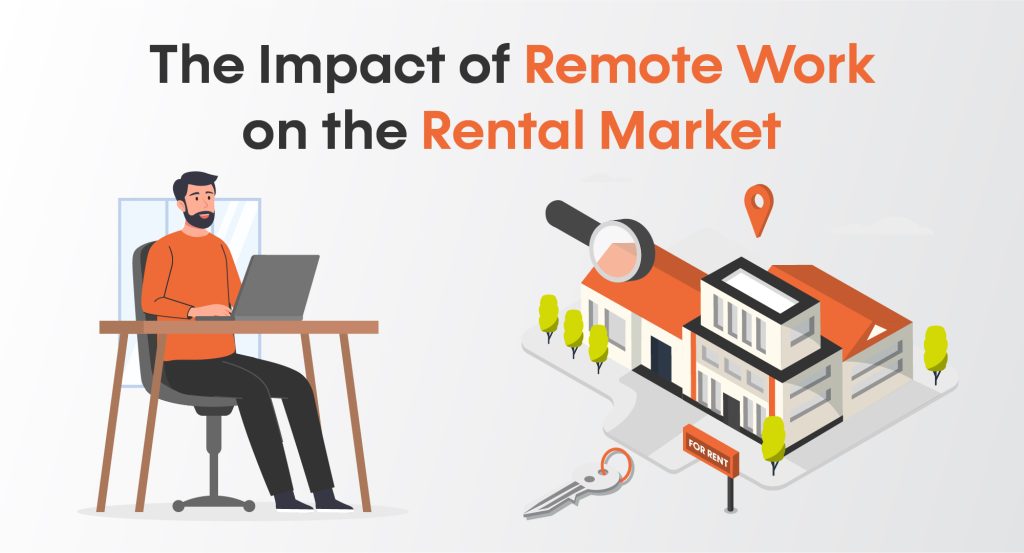The idea of working remotely has grown from a trend to a standard, dramatically changing the dynamics of many industries around the globe. Particularly in India, where digital change and urbanisation are fast changing lives, is the rise of remote employment having an impact on the rental market. This blog delves into the changing world of rental properties, examining how remote work has influenced demand, pricing, and preferences for homes for rent in this bustling city and abroad.
Large cities in India have seen a sharp increase in the rental value of commercial real estate over the last ten years, placing them among the most expensive rental markets in the world. This was also seen in the rental of residential property: tenants in areas near the central business districts of cities like Bangalore, Delhi, Mumbai, and others now have to pay outrageous monthly rents, frequently for living in historic buildings, in order to avoid wasting their valuable time travelling back and forth to work.
Even if tenants could rent far larger residences for much lower rents, the rental real estate on the peripheries could never match its counterparts in the heart of the city on this one point alone.
Demand for Flexible Housing Options
The need for flexible housing choices, such coworking spaces and live-work lofts, is predicted to increase as more individuals choose to work from home. As a result of landlords meeting the demands of remote workers, there can be a rise in the availability of short-term rental units.
Increased Focus on Amenities
Remote employment raises the importance of work-life balance, which focuses attention on facilities like parks, gyms, and entertainment alternatives. This might increase the demand for homes with these characteristics, which could raise the cost of the greatest facilities.
The Function of Telecommuting Hubs
It is anticipated that cities with robust telecommuting amenities, such fast internet and easy access to public transit, will draw in an increasing number of remote workers. These cities might thus see a rise in the demand for homes, which would drive up costs and rental rates.
Suburban vs. Urban Housing’s Effect:
Urban areas with robust telecommuting infrastructure and a bustling social scene may see a shift in the number of people working from home. As remote workers look for urban living options, this could result in a drop in the demand for suburban property.
In Delhi’s upscale central neighborhoods, for example, renting a well-built two-bedroom apartment requires paying a monthly fee of at least a few lakh rupees. In contrast, a similar-configured apartment with greater facilities might be rented for as little as Rs 15,000 a month in Noida. There would be a comparable difference between Navi Mumbai and central Mumbai.
The world’s largest work-from-home experiment was sparked by the coronavirus outbreak, but the peripherals are poised to win against central sites because of their high costs.
As of March of this year, a big number of organisations throughout the world have been allowing their workers to work remotely. Some businesses have already announced intentions to function remotely till the end of the year in response to the ongoing spike in infections despite global lockdowns. Even though there were initial reservations about the idea of working remotely, many people now believe that it might become the standard way to work instead of just an exception.
Tenants who had previously preferred central locations would eventually move to the suburbs, which have an abundance of larger, more reasonably priced homes that are perfect for “work-from-home,” despite having to pay exorbitant rents for smaller configurations and fewer amenities because they could “walk-to-work” and avoid sitting in traffic.
Adapting Rental Preferences and Working Remotely
Due to the COVID-19 pandemic, India, like many other countries, saw a rapid uptake of remote work. Rental preferences have changed significantly as a result of this transformation, which has caused many families and professionals to reevaluate their living arrangements. After years of being restricted by the need to live close to their place of employment, urban people are increasingly looking for more roomy and reasonably priced housing options.
The planned layout and standard of living of Chandigarh, which are well-known, have changed significantly. The need for rental homes in Chandigarh has increased, with tenants giving top priority to features like roomier living quarters, in-home workspaces, and proximity to green spaces. Professionals are becoming more interested in areas like Sector 17, Sector 35, and Zirakpur since they prefer more tranquil, residential settings and accept remote work.
Effect on Rent Prices
There is a complex relationship between remote employment and rental costs in India. Due to a decline in the demand from distant workers, big urban regions initially saw rent reductions; however, cities like Chandigarh observed more stable rental costs or minor increases. The aforementioned trend is indicative of Chandigarh’s attractiveness as a balanced lifestyle metropolis that draws in remote workers who are looking for a blend of suburban peace and metropolitan conveniences.
There have been differences in Chandigarh rental pricing depending on the neighbourhood’s closeness to schools, necessary amenities, and connectivity choices. In response, landlords have adjusted their rental properties to entice tenants searching for Chandigarh houses for rent by providing facilities like flexible lease periods and high-speed internet at cheap prices.
Dynamics of the Rental Market and Digital Transformation
Not only has remote work expedited the digital transition, but it has also altered the way individuals look for rental properties in addition to where they work. Chandigarh’s rental market has become reliant on online platforms and real estate apps, which provide transparency and ease of use for both tenants and landlords.
In addition, the notion of virtual tours and remote leasing procedures has grown in acceptance, enabling potential renters to view properties from the comfort of their existing homes. Remote workers may now find acceptable apartments in Chandigarh and abroad more easily thanks to this digital revolution, which has also improved accessibility and expedited the leasing procedure.
Difficulties and Possibilities for Landlords
The increase in remote employment both creates opportunities and challenges for Chandigarh’s real estate owners and landlords. Rising demand for Chandigarh rental homes might result in stable rental incomes and higher occupancy rates, but it also means adjusting to the tastes and expectations of new tenants. In order to stay competitive in a market that is changing, landlords sometimes need to make improvements to their properties, such as adding home offices or outdoor facilities.
Moreover, Chandigarh property management calls for a deep comprehension of regional laws, tenant rights, and changing market dynamics. Attracting and keeping remote-working renters requires effective property marketing methods that emphasise the property’s closeness to necessities, quality of life amenities, and connectivity possibilities.
Prospects and Strategies for Adaptation
Future prospects for Chandigarh’s rental market and India’s rental sector in general seem strongly tied to the development of remote work. The need for Chandigarh rental homes is expected to persist due to the adoption of hybrid work models by corporations and the preference of individuals for flexible living arrangements. Growing demand from remote workers looking for reasonably priced yet conveniently located locations could also be seen in Chandigarh’s surrounding suburban districts, such as Mohali and Panchkula.
In order to leverage these developments, Chandigarh landlords and property managers must think about making investments in technology-driven solutions, improving on-site amenities, and keeping up with regional market developments. Stakeholders can establish a competitive edge by adjusting to the changing requirements of renters who work remotely and efficiently utilising digital platforms.
Also Read - Top 5 Home Rental Apps Of 2024 – Find The Best For You
In summary
Let’s sum up by saying that remote employment has had an important impact on the Indian rental market, especially in places like Chandigarh. The real estate industry’s digital transformation has accelerated, price dynamics have been impacted, and rental preferences have changed as a result of the shift towards remote work. To make wise selections and prosper in the post-pandemic environment, it is crucial for both landlords managing the changing rental market and tenants searching for a Chandigarh house for rent to comprehend these developments.
With remote work redefining residential preferences and work-life balance, Chandigarh is well-positioned to draw a wide spectrum of professionals who work remotely and are looking for high-quality home options and a high standard of living. Chandigarh’s rental market can sustainably develop and satisfy the demands of a workforce empowered by digital means in the future by welcoming innovation and adjusting to shifting tenant expectations.
If you are looking for House for rent in Chandigarh you can find the same on Lets Rentz. Search now and get excellent results for house for rent. To learn more visit the website or Mobile app of Lets Rentz.



